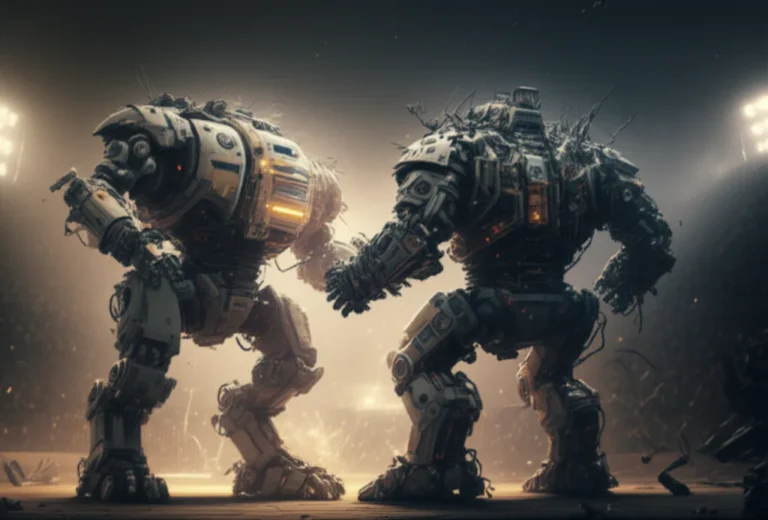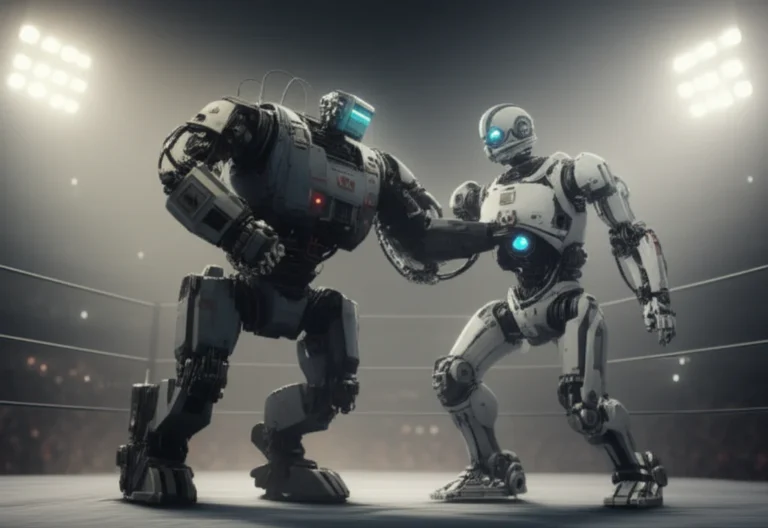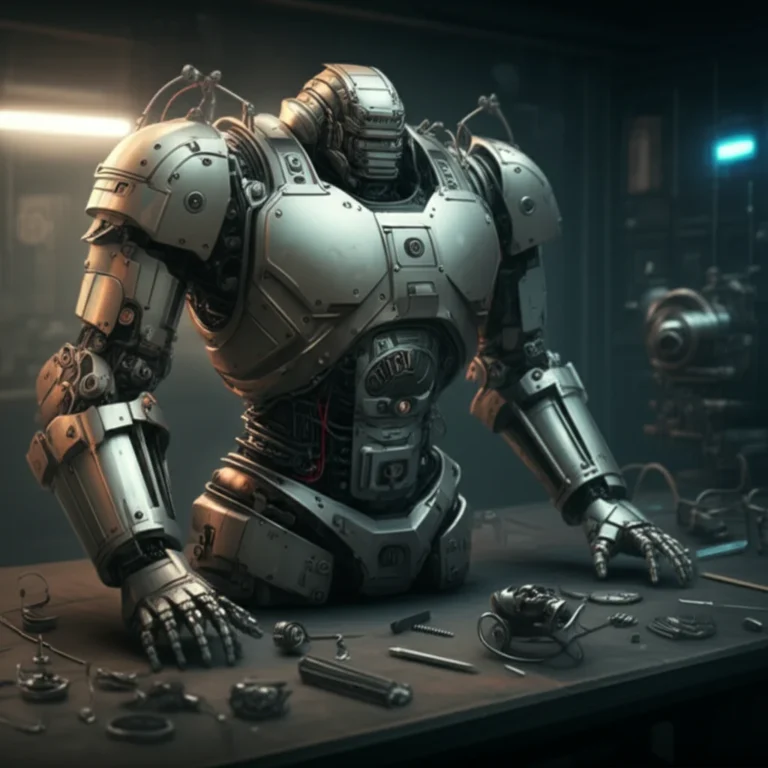Support our educational content for free when you buy through links on our site. Learn more
What Are the Components of a Combat Robot? 8 Essential Parts You Need to Know [2024] 🤖

Have you ever watched a combat robotics competition and wondered what makes those fierce machines tick? 🤔 From the thunderous roar of spinning blades to the heart-stopping moments of a robot being flipped into the air, there’s a lot more than meets the eye! In this article, we’ll break down the 8 essential components that make up a combat robot, ensuring you’re armed with all the knowledge you need to design your own battle bot.
Did you know that the first-ever combat robot competition took place nearly three decades ago? Since then, the technology and strategies have evolved dramatically! Imagine being part of that evolution—designing a robot that not only withstands the blows but also delivers them with precision. Stick around as we guide you through each component and share tips on how to make your robot stand out in the arena!
Key Takeaways
- Understanding the Core Components: Learn about the essential parts, including the chassis, power source, and weapon systems.
- Designing for Success: Discover tips for balancing speed and strength to create a competitive edge.
- Future Trends: Stay informed about upcoming advancements in combat robotics and technology.
- Hands-On Resources: Check out our recommended links for materials and products to help you build your own combat robot.
Ready to dive deeper into the world of combat robots? Let’s get started! 🛠️
Table of Contents
- Quick Tips and Facts about Combat Robots 🤖
- The Evolution of Combat Robots: A Historical Perspective 📜
- Essential Components of a Combat Robot: What You Need to Know 🛠️
- Designing Your Combat Robot: Tips and Tricks for Success 🎨
- Popular Combat Robot Competitions: Where the Action Happens 🏆
- Future Trends in Combat Robotics: What’s Next? 🔮
- Conclusion: Wrapping It All Up 🎁
- Recommended Links for Combat Robot Enthusiasts 🔗
- FAQ: Your Burning Questions Answered ❓
- Reference Links for Further Reading 📚
Quick Tips and Facts about Combat Robots 🤖
Before diving into the nuts and bolts of combat robots, let’s arm you with some quick tips and facts that’ll make you the life of any robot wrestling watch party!
- Size Matters: Combat robots range from tiny 150-gram antweights to massive 220-pound heavyweights. Choose your weight class wisely!
- Speed vs. Strength: A faster robot can dodge attacks, but a stronger robot can deal devastating blows. What’s your strategy?
- Material Choices: Aluminum and titanium are popular for their strength-to-weight ratio. Pro Tip: Use polycarbonate for impact resistance.
- Power Up: Most combat robots use lithium polymer (LiPo) batteries for their high power output and lightweight.
- Control is Key: A reliable radio control system ensures your robot responds accurately during intense battles.
Fun Fact
Did you know that the first combat robot competition was held in 1994? That’s nearly three decades of bots bashing each other to pieces! For more on the history of these epic battles, check out our Robot Pro-Wrestling Kit article.
The Evolution of Combat Robots: A Historical Perspective 📜
Combat robots have come a long way since their inception. Let’s take a stroll down memory lane and see how these metal gladiators have evolved over the years.
The Birth of Combat Robotics
The concept of combat robots emerged in the early 1990s, with the first official competition, Robot Wars, held in 1994 in San Francisco. Enthusiasts quickly gravitated to this thrilling sport, leading to the creation of numerous competitions worldwide, including the famous BattleBots.
Technological Advancements
As technology advanced, so did the complexity and capabilities of combat robots. From primitive remote-controlled machines to sophisticated bots equipped with AI and autonomous features, the evolution has been nothing short of spectacular. Read more about famous matches that showcased these advancements.
The Modern Era
Today, combat robots are a blend of cutting-edge technology and strategic design. With global competitions and televised events, the sport has reached new heights, captivating audiences with its blend of engineering prowess and sheer entertainment.
Essential Components of a Combat Robot: What You Need to Know 🛠️
Building a combat robot is like assembling a mechanical jigsaw puzzle. Each component plays a crucial role in your bot’s performance. Let’s break it down!
1. Chassis: The Backbone of Your Battle Bot 🏗️
The chassis is the framework that holds everything together. It must be sturdy enough to withstand impacts yet lightweight to maintain agility.
- Material Options: Aluminum (6061-T6) and titanium are popular for their strength and machinability.
- Design Considerations: Opt for a low center of gravity to improve stability. Explore more robot design tips.
2. Power Source: Fueling the Fight ⚡
Without power, your robot is just a paperweight. Choose a power source that balances energy output with weight.
- Battery Types: LiPo batteries are preferred for their high energy density.
- Capacity and Voltage: Ensure your battery can supply enough power for the entire match duration.
3. Drive System: The Wheels That Win 🏎️
Your drive system determines how your robot moves. Speed and maneuverability are critical in dodging attacks and positioning your bot for a strike.
- Motor Choices: Drill motors are affordable and effective for smaller bots. For larger robots, consider Banebots motors.
- Wheel Options: Colson wheels offer excellent grip and durability. Learn more about choosing the right components.
4. Weapon Systems: The Art of Destruction 🔥
The weapon is your robot’s primary offensive tool. Choose a weapon that complements your strategy.
- Types: Spinners, flippers, and hammers are popular choices.
- Material and Design: Use hardened steel or titanium for durability. Ensure the weapon is balanced to prevent destabilizing your bot.
5. Control System: The Brain Behind the Bot 🧠
A reliable control system is essential for precision and responsiveness.
- Radio Systems: 2.4 GHz systems are recommended to minimize interference.
- Speed Controllers: Ensure each motor has a proportional speed controller for smooth operation.
6. Sensors: Eyes and Ears of the Combat Robot 👀
Sensors provide crucial data to help you navigate and strategize during a match.
- Common Sensors: Infrared, ultrasonic, and gyroscopic sensors can enhance your bot’s awareness and control.
- Integration: Ensure your sensors are compatible with your control system for seamless operation.
7. Armor and Defense: Shielding Your Robot from Damage 🛡️
Armor protects your robot from enemy attacks. Choose materials that offer maximum protection without adding excessive weight.
- Material Choices: Polycarbonate and titanium are excellent for absorbing impact.
- Design Tips: Reinforce vulnerable areas and consider modular armor for easy repairs.
8. Communication Systems: Staying Connected 📡
Maintain a strong communication link between your robot and controller to ensure reliable performance.
- System Options: Opt for a robust radio frequency that minimizes latency and interference.
- Backup Systems: Consider a secondary communication channel for redundancy.
Designing Your Combat Robot: Tips and Tricks for Success 🎨
Designing a combat robot is both an art and a science. Here are some insider tips to help your bot stand out in the arena.
Start with a Plan
Sketch your design and identify key components. Use Computer-Aided Design (CAD) software like Autodesk Inventor or Solidworks to visualize and refine your design. Learn more about CAD in our Robot Design section.
Test and Iterate
Build prototypes and test each subsystem separately. This allows you to identify and address issues before the final assembly. Remember, the more you test, the better your bot will perform.
Balance is Key
Ensure your robot’s weight distribution is balanced to prevent tipping during intense maneuvers. Adjust your design as needed to achieve optimal stability.
Popular Combat Robot Competitions: Where the Action Happens 🏆
Combat robot competitions are the ultimate test of your bot’s mettle. Here are some of the most popular events where you can showcase your creation.
BattleBots
Arguably the most famous combat robot competition, BattleBots features top-tier robots from around the world. The event is televised, offering a platform for builders to gain recognition.
RoboGames
Dubbed the “Olympics of Robots,” RoboGames hosts a variety of robot competitions, including combat events. It’s a great opportunity to meet fellow enthusiasts and learn from the best.
Robot Wars
Originally a UK-based competition, Robot Wars has gained international fame for its thrilling battles. The event attracts a diverse range of robots and offers a unique challenge for builders.
Future Trends in Combat Robotics: What’s Next? 🔮
As technology continues to evolve, so too does the world of combat robotics. Here are some trends to watch out for in the coming years.
Increased Autonomy
With advances in AI and machine learning, future combat robots may feature autonomous capabilities, allowing them to make real-time decisions during matches.
Advanced Materials
New materials, such as carbon nanotubes and graphene, could revolutionize robot design by offering unprecedented strength and lightweight properties.
Enhanced Sensors
Improved sensor technology will enable robots to gather more data and respond more effectively to their environment, leading to smarter and more strategic battles.
Stay tuned for more insights and updates on the exciting world of combat robotics! Don’t forget to check out our Opinion Pieces and Event Announcements for the latest news and expert opinions.
Conclusion: Wrapping It All Up 🎁

Building a combat robot is a thrilling journey that combines engineering prowess with strategic thinking. From selecting the right chassis to mastering the weapon systems, each component plays a crucial role in determining your bot’s success in the arena.
Summary of Positives and Negatives
Positives:
- Creative Expression: Designing a combat robot allows you to unleash your creativity and engineering skills.
- Competitive Spirit: Engaging in robot battles cultivates a sense of camaraderie and healthy competition among enthusiasts.
- Learning Experience: The process of building and refining your robot teaches valuable skills in engineering, programming, and problem-solving.
Negatives:
- Costly Components: High-quality parts can be expensive, and costs can add up quickly.
- Time-Consuming: Designing, building, and testing your robot requires significant time and effort.
- Potential for Frustration: Not all designs will work as planned, leading to iterative testing and modifications.
Overall, we confidently recommend diving into the world of combat robotics! Whether you’re a seasoned engineer or a curious beginner, the thrill of competition and the joy of creation await you.
Recommended Links for Combat Robot Enthusiasts 🔗
- Chassis Materials:
- Aluminum: Search on Amazon | Search on Walmart | Aluminum Official Website
- Motors:
- Banebots: Search on Amazon | Banebots Official Website
- Battery Packs:
- LiPo Batteries: Search on Amazon | Search on Walmart | Battle Packs Official Website
- Books on Robot Design:
- “Robot Building for Beginners” – Amazon Link
- “The Art of Electronics” – Amazon Link
FAQ: Your Burning Questions Answered ❓

What are the 5 main components of a robot?
Understanding the Core Components
- Manipulator: The “arm” of the robot, consisting of joints and linkages.
- End Effector: The “hand” that performs tasks like gripping or welding.
- Sensors: Devices that provide feedback on the robot’s environment and actions.
- Controller: The brain that processes input and controls the robot’s movements.
- Locomotive Devices: The motors and wheels that enable movement.
Read more about “How Much Does a Nao Robot Cost? Unveiling the Price in 2024! 🤖”
What are the components of a battlebot?
Key Elements of a Combat Robot
- Chassis: The structural frame.
- Power Source: Typically batteries (like LiPo) for energy.
- Drive System: Motors and wheels for navigation.
- Weapon Systems: Offensive tools like flippers or spinners.
- Control System: Remote control and speed controllers for maneuvering.
Read more about “Do BattleBot Champions Win Money? …”
What are combat robots made of?
Material Choices for Durability
Combat robots are often constructed from:
- Aluminum: Lightweight and strong.
- Titanium: Excellent for armor but more expensive.
- Polycarbonate: Used for protective shields due to its impact resistance.
- UHMW: Durable plastic for internal components.
How to make a fighting robot?
Step-by-Step Guide to Building Your Bot
- Research: Understand the rules of your competition.
- Design: Use CAD software to plan your robot.
- Select Components: Choose materials and parts based on your design.
- Build: Assemble your robot, ensuring all parts fit and function.
- Test: Run trials to identify and fix any issues before competition day.
What is the best weapon for a combat robot?
Choosing Your Armament
The best weapon depends on your strategy:
- Spinner: Great for causing damage and knocking opponents off balance.
- Flipper: Excellent for tossing opponents out of the arena.
- Hammer: Provides powerful strikes but requires precise timing.
Read more about “Remote Control Fighting Robot Toys: Unleash the Battle in Your Living Room! … 🤖💥”
How can I improve my combat robot’s performance?
Tips for Enhancing Your Bot
- Weight Distribution: Ensure your robot is balanced for stability.
- Testing: Regularly test and tweak your design for optimal performance.
- Upgrades: Stay updated with new technology and materials to enhance your robot.
Reference Links for Further Reading 📚
- Instructables: How to Design and Build a Combat Robot
- Online Robotics: What Are the 5 Main Components of Industrial Robots?
- Online Metals: Combat Robotics Weapons and Armor
Now that you’re armed with knowledge, go forth and create the ultimate combat robot! May the best bot win! 🏆🤖





